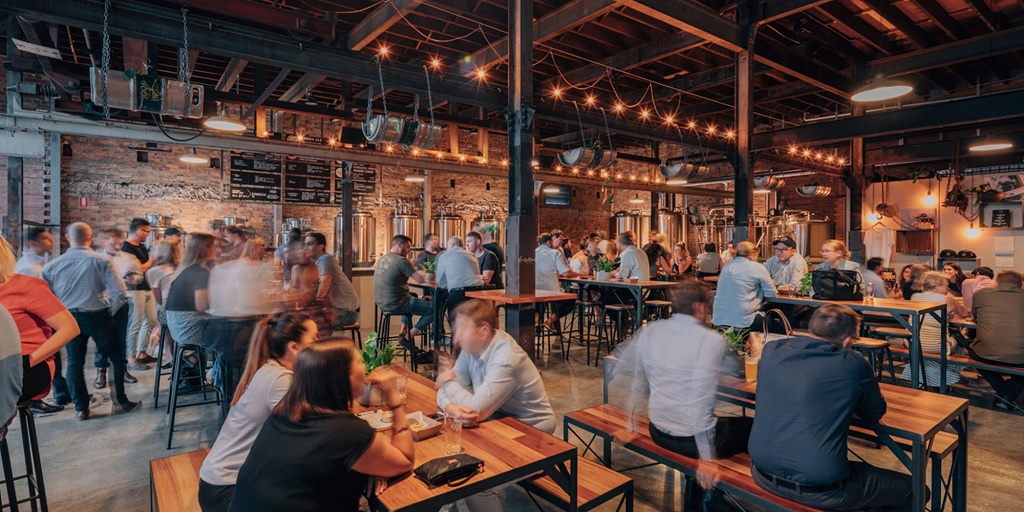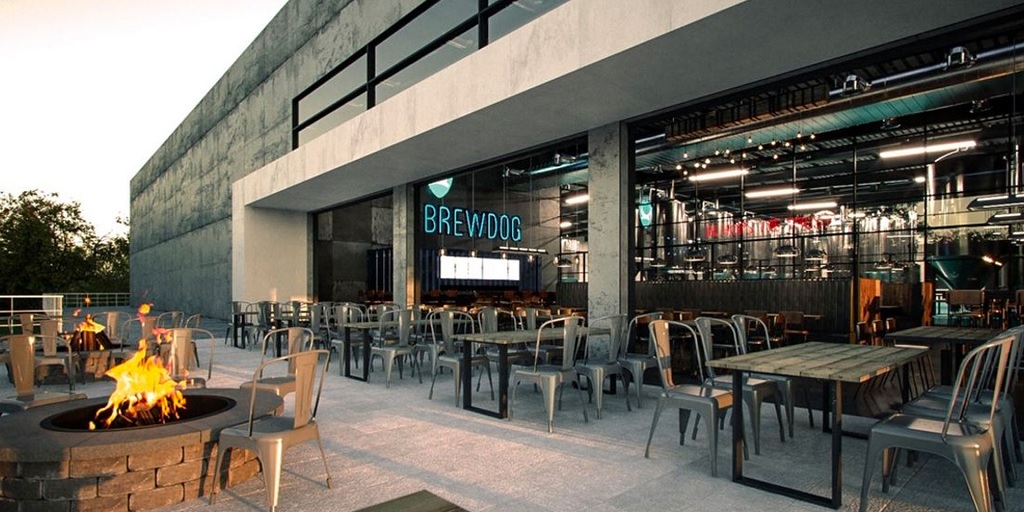
Venue or supplier, the challenging balance breweries face

Stone & Wood’s Brisbane taproom and microbrewery
Brewery taprooms are an important element in building a brand, even for breweries with a national wholesale footprint. But filling the role of both wholesaler and retailer has the potential to bring breweries into competition with their best customers.
BrewDog and Stone & Wood have both opened venues in Brisbane in the past month, with very different approaches to this potential issue.
Stone & Wood recently tapped into its laid-back Byron Bay roots with a low-key launch for its Brisbane taproom and microbrewery in a prime CBD spot. By comparison, BrewDog pulled out all the stops with an influencer and media pre-launch night at its out-of-the-way riverside brewery venue, a separate official launch day with the Minister for State Development, Cameron Dick, and an assortment of various local dignitaries.
But this wasn’t the only difference in approach between the two craft heavyweights.
Nick Boots, head of sales at Stone & Wood said that its taprooms are intentionally very different to its customers’ venues, and indeed its Brisbane venue only sells pots, rather than schooners and pints to reduce direct competition.
“The taproom focus is brewing, brand experience and drinker education.
“Our aim is to actually increase the sales of our beers in neighbouring venues by first educating taproom visitors and then encouraging them to visit our neighbours to experience our beer in their awesome venues,” he said.
“We offer no entertainment, TV sport, gaming, wine or spirits and very limited food; it’s an entirely different offer that’s very complementary.”
Meanwhile, the BrewDog venue is a different beast, not only acting as the Scottish brewery’s production base in Australia, but also as its first flagship venue with ambitions plans for further roll outs.
BrewDog founder Martin Dickie explained that the DogTaps exist where the Scottish brewery had both a production operation and a venue – so its Berlin and Columbus venues are branded as such.
The aim of DogTap Brisbane was to provide a production base for its Australian expansion plans – cutting out the expensive 57-day cold shipping freight route it currently uses to send its beer to Australia from its home in Ellon, Scotland. From this base, the brewery is also eyeing stand-alone venues as well.
Dickie explained that the purpose of having a brewery and venue was to give BrewDog a foothold in Australia.
“From a selfish standpoint, if I’m out on holiday in Australia and I want to be able to drink our beer, do some tasting events and to really have our beer in the market properly we have to be creating it in Australia.
“That’s the reason for the brewery here and it’s awesome to have the site that we have to be able to open it up to the community, and the way we work all our taprooms is that ability to focus on our beers and the best craft brewers in the area as well.”
While it has been reported that the Brisbane brewery cost $30 million, it actually cost significantly less than that as the balance is earmarked for its total investment into Australia as a key market, including bars. The Scottish brewery has offered incentives to consumers to help it find suitable locations for its bar expansion.
Dickie said he didn’t believe the brewer was stepping on the toes of the venues that support it, saying BrewDog’s model could actually benefit its customers in Brisbane and South East Queensland.
“I think it works really well. It sounds like it shouldn’t but in places where we’ve put a bar it helps the bars around us and increases our sales of our own beer, and having our own focal point it just generally draws attention to the fact that our beers are there,” he said.
Stone & Wood has taken a softer approach when it comes to their taprooms, both in Brisbane and Byron Bay.
“The local venue relationships are about transparency and partnership,” Boots said.
“If the taproom offer is differentiated enough to not compete with traditional venues, most venues will see the opportunity to partner with a local indie brewer and provide support.”
Its Byron Bay taproom is primarily a tasting venue, which the brewer uses to test out new beers on fans who head out to the site, without selling full sized pints or schooners and offering only a limited food menu, so as not to threaten the business of its customers in the vicinity, similar to its Brisbane site.
While community-minded, this small-serve approach has come at a potential cost, with some online reviews of the Brisbane venue criticising the lack of schooners and pints.
While taprooms aren’t a necessity, Boots said the venues play an important role in drinker engagement, which was the primary goal for Stone & Wood.
“For a start-up small scale brewer, it’s a great way to start as wholesale distribution comes with a number of complexities,” Boots said.
“Once established, viewing a taproom as a component of your marketing mix rather than a profit making opportunity is a good mindset. If you can break-even or deliver a small profit while delivering on your marketing objectives, then that’s a bonus.”
Line between supplier and competitor
The decision about where to draw the line between competitor and supplier comes down to where a business wants to sit in its core market.
Peter Gross, general manager at Brisbane’s Black Pearl Epicure, one of the city’s largest speciality providores, said that the company closed down its retail store after its core customers felt it was too much competition.
“You have to be very, very careful. I used to see a guy, a customer, and he would sit me down and start off saying, you’re one of my biggest and best suppliers and my biggest competitor.
“Over time that really sunk in with me, I felt we couldn’t legitimately do both.”
He said there are other concerns when looking at the complexity of the supplier-customer-competitor relationship.
“You have to be really careful on pricing, consumers come to see you and they expect things as a ‘factory outlet’ so to speak, it should be cheaper than elsewhere. But if you do that you’re thumbing your nose at the people that buy off you.
“In the end we were looking upon the retail store as a bit of a promotional thing, where people come in and have samples, taste a wide array of products we had.”
Gross describes a similar business model to that which Stone & Wood has employed.
“That’s a great strategy, with everyone else having schooners and pints, you come in with a pot and it’s hard to price compare and that is great,” he said.
“Look at some restaurants, wines on wine list that aren’t well known so that the punter can’t sit in the restaurant and compare and say it was on special elsewhere.
“All the entertaining businesses we’re in are very difficult, we have to make the right margins.”
Craft beer takeover
The idea that a venue is a means to an end in terms of educating drinkers about the brand and craft beer in general instead of a major profit making element of a business is one shared by BrewDog, said Dickie.
He took a holistic approach when it came to analysing the impact BrewDog might have on Queensland’s brewing industry. He said that BrewDog’s broader appeal could prove to be a gateway for bringing drinkers into craft beer.
“The big thing for us is how we get new people into craft beer and widen that circle every year,” he said.
“If we’re able to be one of the craft breweries that has a slightly broader appeal and bring people into craft beer then it’s good for everyone.”
He said this was the reason they brought in local brewers for guest taps at their venues.
“To be a destination where people hang out for a day and they’re maybe not craft beer drinkers, then they’ll come and see the board and see Balter and Black Hops, Land & Sea and have an opportunity to try their beer and see how good they are.
“Hopefully we can convert non-craft beer drinkers into craft beer drinkers and then they’re like ‘shit, that Black Hops beer was pretty good, I’m going to go down the coast to see their brewery’ – hopefully converting more people to the craft beer journey.”
Dickie said he wasn’t concerned with either the competition from local brewers or with local venues.
“I’m not sure I really think or care about whether it’s a competitive market or not. If craft beer is doing well in a market then more people are going to come into the industry. It’s the same in any industry, if things are going well, everyone’s going to want a piece of that,” he explained.

Matt McIver, founder of Brisbane’s Range Brewing, attended the BrewDog launch and said the advent of BrewDog should be something to celebrate, with the potential for the industry to attract more beer tourists to Queensland as a result.
“It’s easy to take that view and say BrewDog is stepping on our toes, but if other breweries could be in their shoes and opening breweries up worldwide, I think they would as well,” McIver said.
“It’s hard to comment for the rest of Brisbane brewers but I don’t feel that way.
“If anything, having a world-renowned brewery like BrewDog here will only bring more beer tourists to Brisbane. If they’re coming for BrewDog initially, they will end up going to all our local breweries which can only be a good thing.”
Dickie said it was part of brewery’s responsibilities to the sector to always have the growth of the industry as a whole at the back of their mind.
“That’s one of the big things everyone really should focus on a little bit, it’s not just about catering for the current people that drink craft beer, it’s always about how we widen that circle of people,” he said.
“It’s about educating people softly, so you know they don’t realise you’re teaching them stuff but it’s an awesome way for people to learn slowly and enjoy a better product at the end of the day.”



